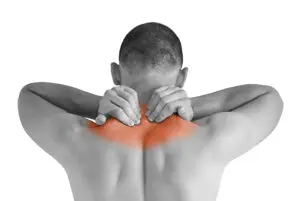Cervicogenic headache treatment Brisbane – If you are experiencing a headache at the back or top of your head, accompanied by neck pain and stiffness, it is a great chance you have a cervicogenic headache. This article will review different headache types, explain causes and symptoms of cervicogenic headaches, and what solutions Myotherapists can offer for headache treatment in Brisbane
Headache is an extremely common issue, and practically every person has occasional headaches.According to WHO, headache affects over one third of men and over one half of women in developed countries, when up to 1 adult in 20 has a headache every – or nearly every – day.There are many types of headaches which can be triggered by various causes, such as stress, tiredness, eyestrain, high blood pressure, infections, hormonal swings, allergy, caffeine, as well as head or neck injuries.
What is cervicogenic headache?
A cervicogenic headache is a secondary headache, it means that the pain does not originate in the head but is caused by other underlying condition. Cervicogenic headache is a referred pain caused by a musculoskeletal dysfunction of the neck. It may be triggered by issues with the cervical joints, nerves or muscles in the neck or the back of the head.
What causes cervicogenic headache and what is the mechanism of pain referral?
According to research, a cervicogenic headache is caused by irritation of cervical structures innervated by spinal nerves C1, C2, and C3. It may include issues with intervertebral discs, cervical facets, nerve roots, trigger points in muscles of the neck and suboccipital area.
The pain referral mechanism from the cervical spine to the head, face, or eyes is explained by the convergence of sensory nerves from C1-C3 and Trigeminal nerve at the trigeminocervical nucleus. As Trigeminal nerve provides a sensory innervation to the eye, skin of the upper face and front of the scalp, and responsible for motor control of some jaw muscles, it explains why joint and muscle issues in upper neck or TMJ can manifest in painful sensations around the head and face and produce so-called TMJ headache, or headache with neck pain.
It has also been suggested that the Accessory nerve, which innervates sternocleidomastoid (SCM) and trapezius muscles, is also involved in this mechanism of pain referral due to connection of its nerve fibres with the upper cervical nerve roots.
So, if you had neck trauma, whiplash, muscle strain, or experiencing chronic tension and spasm of scalp, neck, or shoulder muscles – it all can increase the sensitivity of the area and make you more prone to cervicogenic headaches.
What are the symptoms of cervicogenic headache?
Cervicogenic headache could be confused with a migraine, tension headaches, or other primary headache syndromes because some of the symptoms may be similar. Some people with a cervicogenic headache can experience migraine-like symptoms – nausea, dizziness, blurred vision, pain in the arm or shoulder, sensitivity to loud noise or a bright light.
The most distinguished symptoms of a cervicogenic headache:
- Unilateral head or face pain
- Headache usually starts after a sudden neck movement
- Reduced range of motion and stiffness of the neck
- Headache behind eyes, or at the back of your head
- Headache with coughing or sneezing
What is the best headache treatment, and what should you do for headache relief?
If you experience headache at the back or top of your head, headache behind eyes, and also feel stiff neck or shoulder pain seek consultation of an experienced therapist, who will assess your pain and distinguish the cause of your headache.
If the headache has a musculoskeletal origin – referral pain from tight muscles around the head, neck and shoulders, joint or nerve related pain – headache treatment can be treated by Myotherapists, osteopaths, chiropractors or physiotherapists.
If you have other symptoms in addition to the headache, like vision problems, increased temperature or blood pressure, vomiting, very severe throbbing pain in your head – you should seek treatment of a medical practitioner.
How do you diagnose a cervicogenic headache?
- As part of headache treatment and diagnosis, your myotherapist will ask questions about your health history and will conduct a physical examination, such as: postural observation
- palpation around the head and neck for areas of increased tension, tenderness or swelling
- cervical joint and ligament assessment, for the signs of reduced or excessive joint movement
- muscle and nerve testing around the head, neck, and shoulders, which could indicate a nerve problem in the neck.
- Some other advanced diagnostic techniques for cervicogenic headache include nerve block injections and medical imaging.
Myotherapy for cervicogenic headache treatment Brisbane
There are different techniques that your Myotherapist can use for cervicogenic headache treatment to decrease tension and pain in the muscles, work on joint and nerve pain. These techniques include:
- muscles and fascia release, including trigger point therapy, muscle energy technique, myofascial release
- joint mobilization, particularly of C1-C3 segments
- Nerve manipulation
- myofascial dry needling
- low level laser therapy
- exercise therapy (stretching, strengthening, mobility)
There are also manual techniques and exercises for a self-headache treatment that you can do at home or at work, such as self-massage of painful areas around the neck and head, stretching and strengthening of neck muscles. They often provide headache relief and help in prevention of chronic headaches.
FAQ
Links
https://www.healthline.com/health/headache/cervicogenic-headache
https://www.medicalnewstoday.com/articles/324108
https://www.ncbi.nlm.nih.gov/pmc/articles/PMC5759906/
https://www.patientcareonline.com/view/tension-and-cervicogenic-headaches
https://pubmed.ncbi.nlm.nih.gov/22034615/
https://pubmed.ncbi.nlm.nih.gov/24421621/
https://pubmed.ncbi.nlm.nih.gov/20428974/
https://pubmed.ncbi.nlm.nih.gov/11403744/
https://www.spine-health.com/conditions/spine-anatomy/cervical-spinal-nerves
https://www.spine-health.com/conditions/neck-pain/what-causes-neck-pain-and-dizziness
Related Posts

Stiff Neck Joint Pain, Facet joints may be the issue

Shoulder Pain Brisbane, Managing your shoulder pain

Neck Pain Brisbane

Liza Markova








Latest posts by Liza Markova (see all)
- Frozen Shoulder Brisbane - September 13th, 2023
- Thoracic Outlet Syndrome Brisbane - September 27th, 2022
- SIJ Pain Brisbane - February 4th, 2022

